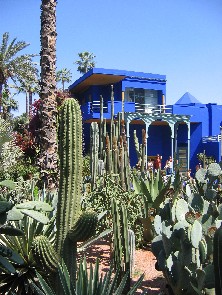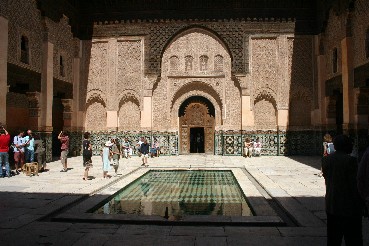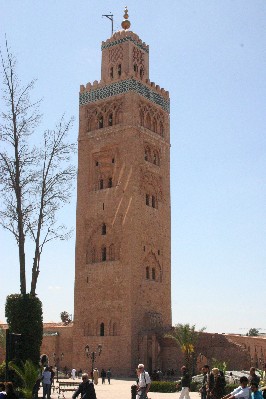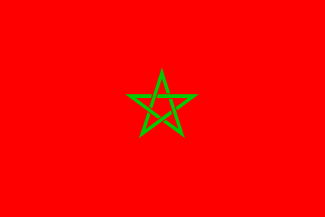Friday 13 April 2007
We have booked a guide for
today. He was supposed to meet us at 9am, but gone 9.30 were are still waiting.
We ask reception to give him a buzz. He then asks if we postpone the tour to the
afternoon. We do not want that. He manages to get to the hotel by 10am. He
claims to have been held up in traffic, but we have  the
impression that has been the
impression that has been  doing
some heavy partying, way into the wee hours of the morning. Apparently he is
still fighting off a bad hangover. We can still smell the alcohol on his
breath. He does not seem to like walking, because he takes us in his car
through the many too narrow streets of the old town. Sometimes people have to
jump into the shops to avoid getting hit by the car. On two occasions we do hit
people on bicycles, fortunately without causing injuries. He drives us via an
enormous detour to the Jardin
Majorelle. This garden was a project of the French painter Jacques Majorelle
in the 1920's. He started with the garden in 1924 and since 1947 the garden is
open to the public. About 10 years ago the garden was bought by Yves Saint
Laurent and Pierre Bergé. It is a beautiful botanic garden with many exotic and
colourful plants and trees. We see many cactuses and even a bamboo forest. It is
very popular and the garden is really to small to deal with this number of
visitors. With the car we drive again through the narrow streets of the old
town, sometimes almost right through the merchandise of the shops. We feel
embarrassed. We reach the Medersa Ben Youssouf. It is an old Koran
school from the 15th century. It's architecture resembles that of the Moorish
buildings in Granada in southern Spain. The building is doing
some heavy partying, way into the wee hours of the morning. Apparently he is
still fighting off a bad hangover. We can still smell the alcohol on his
breath. He does not seem to like walking, because he takes us in his car
through the many too narrow streets of the old town. Sometimes people have to
jump into the shops to avoid getting hit by the car. On two occasions we do hit
people on bicycles, fortunately without causing injuries. He drives us via an
enormous detour to the Jardin
Majorelle. This garden was a project of the French painter Jacques Majorelle
in the 1920's. He started with the garden in 1924 and since 1947 the garden is
open to the public. About 10 years ago the garden was bought by Yves Saint
Laurent and Pierre Bergé. It is a beautiful botanic garden with many exotic and
colourful plants and trees. We see many cactuses and even a bamboo forest. It is
very popular and the garden is really to small to deal with this number of
visitors. With the car we drive again through the narrow streets of the old
town, sometimes almost right through the merchandise of the shops. We feel
embarrassed. We reach the Medersa Ben Youssouf. It is an old Koran
school from the 15th century. It's architecture resembles that of the Moorish
buildings in Granada in southern Spain. The building is built around a courtyard. On the upper floors are the cells, where the students
used to study and sleep. The walls are covered with decorated cedar wood. At the
far end of the courtyard is the prayer hall, where the decorations are most
attractive with many fir cone and palm motives, which is unusual in Moorish
stucco. Our guide does not join us. We are
left to our own devices and have to manage with our guide book (Rough
Guide to Morocco). The next stop is the tannery. Via a handicraft shop we
get to a rooftop vantage point from where we can watch the tanners go about
their business. In Marrakech the skins are not colour dyed, like they do in Fes.
There are not many tanners today as it is a Friday, the day of the most
important prayer service of the week. The smell is not half bad. Back in the
shop people try to sell us things we do not want. We endure it for the benefit
of the view we just had. There is also a Berber pharmacy, which is fun. They
sell natural remedies for all kind of thinkable and unthinkable ailments. We
get a massage with an oil extracted from the goat tree, to be found between Essouira
and Agadir. The tree is called that name because goats climb
built around a courtyard. On the upper floors are the cells, where the students
used to study and sleep. The walls are covered with decorated cedar wood. At the
far end of the courtyard is the prayer hall, where the decorations are most
attractive with many fir cone and palm motives, which is unusual in Moorish
stucco. Our guide does not join us. We are
left to our own devices and have to manage with our guide book (Rough
Guide to Morocco). The next stop is the tannery. Via a handicraft shop we
get to a rooftop vantage point from where we can watch the tanners go about
their business. In Marrakech the skins are not colour dyed, like they do in Fes.
There are not many tanners today as it is a Friday, the day of the most
important prayer service of the week. The smell is not half bad. Back in the
shop people try to sell us things we do not want. We endure it for the benefit
of the view we just had. There is also a Berber pharmacy, which is fun. They
sell natural remedies for all kind of thinkable and unthinkable ailments. We
get a massage with an oil extracted from the goat tree, to be found between Essouira
and Agadir. The tree is called that name because goats climb the branches to get to the leaves and eat them. The massage feels great.
We pay for the massage, but do not buy any of the wonder medicines. We say
no even to the bitter orange cream against depression or a ginseng like
concoction for optimized libido ("eight till ten times a day, will be no
problem anymore") and other cures of that nature. Next stop is the Koutoubia
mosque, the largest and most important mosque of Marrakech with a 12t
the branches to get to the leaves and eat them. The massage feels great.
We pay for the massage, but do not buy any of the wonder medicines. We say
no even to the bitter orange cream against depression or a ginseng like
concoction for optimized libido ("eight till ten times a day, will be no
problem anymore") and other cures of that nature. Next stop is the Koutoubia
mosque, the largest and most important mosque of Marrakech with a 12t h
century minaret. This minaret can be seen from far away and is a symbol for the
city. The minaret has similarities with the Giralda of Seville in Spain. The
minaret is crowned with three large copper balls. Probably the ball were once
made of gold. and were a gift from the wife of Sultan Yacoub el Mansour
(1184-99), as a penance for breaking the fast for three hours during Ramadan. It
is Friday and the great prayer service is in full swing. The mosque is filled to
capacity with praying men. This partly the reason why many shops are closed
today. We walk around the mosque (we cannot enter as non-believers), and peek
inside. Our guide - yet again not adding any useful information - drives us back
in the direction of the hotel. We say goodbye to the guide and go for lunch
at restaurant Douriya, which has been renamed Brasserie
Tanjia. The guide insists tagging along in order to introduce us there. It
will get him a commission no doubt. We have a delicious lunch on the shaded roof
top. h
century minaret. This minaret can be seen from far away and is a symbol for the
city. The minaret has similarities with the Giralda of Seville in Spain. The
minaret is crowned with three large copper balls. Probably the ball were once
made of gold. and were a gift from the wife of Sultan Yacoub el Mansour
(1184-99), as a penance for breaking the fast for three hours during Ramadan. It
is Friday and the great prayer service is in full swing. The mosque is filled to
capacity with praying men. This partly the reason why many shops are closed
today. We walk around the mosque (we cannot enter as non-believers), and peek
inside. Our guide - yet again not adding any useful information - drives us back
in the direction of the hotel. We say goodbye to the guide and go for lunch
at restaurant Douriya, which has been renamed Brasserie
Tanjia. The guide insists tagging along in order to introduce us there. It
will get him a commission no doubt. We have a delicious lunch on the shaded roof
top.
We retire for a while in the
Riad. Around 4.30 we go out again to visit the Saadian tombs. These
tombs from the Saadian dynasty (16th century) have been neglected and
hidden for centuries after the establishment of the Alouïte dynasty (to which
the present King also belongs) until they were rediscovered in the 20th century
(1917) on a aerial photo. They were beautifully restored and a garden was made a round
them. A tunnel leads visitors around a mosque that now separates the tombs from
the street. The tombs are beautifully decorated and the style resembles that of
the
Medersa Ben Youssouf. The most attractive tombs can be seen through a narrow
doorway and we have to wait in a long line for our turn. After visiting
the tombs we walk once more to the Djemaa el Fna and sit down again on the
roof top of the CMT hotel. Again it is very quiet on this roof top - quite
unlike the other roof top café's - despite the great and unrestricted view of
the square. Maybe it is because of the poor impression of the hotel itself. We
again enjoy the view on the snake charmers who seduce unsuspecting tourists into
getting their picture taken with the snakes, for which they are asked to pay
dearly afterwards. We return to the hotel by 6pm. Tonight we eat in our Riad Kaiss.
A table is set in a lovely loggia with a view of the patio. It is quite a
romantic setting, at the backdrop of the tastefully illuminated courtyard, the
fountain and the orange trees. The food is heavy and we are completely filled by
the time we leave the table. The nice Moroccan Cabernet Sauvignon from Meknes
tastes wonderfully well with the tajines. In all it is a great finale of our
stay in Morocco. We go to bed early, because we have a very early start
tomorrow. round
them. A tunnel leads visitors around a mosque that now separates the tombs from
the street. The tombs are beautifully decorated and the style resembles that of
the
Medersa Ben Youssouf. The most attractive tombs can be seen through a narrow
doorway and we have to wait in a long line for our turn. After visiting
the tombs we walk once more to the Djemaa el Fna and sit down again on the
roof top of the CMT hotel. Again it is very quiet on this roof top - quite
unlike the other roof top café's - despite the great and unrestricted view of
the square. Maybe it is because of the poor impression of the hotel itself. We
again enjoy the view on the snake charmers who seduce unsuspecting tourists into
getting their picture taken with the snakes, for which they are asked to pay
dearly afterwards. We return to the hotel by 6pm. Tonight we eat in our Riad Kaiss.
A table is set in a lovely loggia with a view of the patio. It is quite a
romantic setting, at the backdrop of the tastefully illuminated courtyard, the
fountain and the orange trees. The food is heavy and we are completely filled by
the time we leave the table. The nice Moroccan Cabernet Sauvignon from Meknes
tastes wonderfully well with the tajines. In all it is a great finale of our
stay in Morocco. We go to bed early, because we have a very early start
tomorrow.
Weather: sun, 26°C/79°F.
Saturday 14 April
2007
We rise early, around 5.45am. We
have breakfast on the patio. A taxi picks us up promptly at 6.30 and takes us to
the airport. The roads are deserted. The airport is in complete chaos. The
departure hall is too small for the crowd. We 2 hours before take off and our
flight is not even shown on the information screens. That does not happen until
45 minutes before departure. We have to line up in front of desk 4. Check-in
progresses very slowly and line 3 starts merging with ours because their agent
has mysteriously disappeared 20 minutes prior to departure we are checked
in for our first flight segment to London. The system does not allow a check in
for the connecting flight to Amsterdam. The baggage gets a label for Amsterdam.
Next is lining up for passport control. That does not take long so we go
immediately on to the aircraft. We take off about 20 minutes late. After 20
minutes we land in Casablanca, where we stay on the ground for about 40 minutes
to pick up passengers, cargo and fuel. Then it is another 2 hrs and 50 minutes
to London Heathrow. Oddly enough we get there 10 minutes early. There starts our
long slog from Terminal 1 to Terminal 4. Security check - bus ride - check-in,
followed by a 2 hour wait. We have a couple of drinks at the airport pub before
we board the plane to Amsterdam. The flight is only booked for 35% of the seats,
so we have all the space we want. After some delay caused by understaffed
baggage handlers we are off to Amsterdam where land right on time. We catch the
8.15 train to Rotterdam. The taxi driver in Rotterdam has never heard of our
street, although it is in the middle of the city. Nor does he know many other
streets in the neighbourhood. He has just started his taxi company, but has yet
to learn his local geography. We are home somewhat before 10pm.
|


